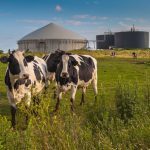Anaerobic digestion of glycerol involves the biological breakdown of glycerol, a byproduct of biodiesel production and a component of triglycerides, in the absence of oxygen. This process typically occurs through microbial activity and can be considered a form of anaerobic fermentation.
Methane and biogas production from this anaerobic digestion of crude glycerol is a very useful way of handling a relatively abundant product from the biodiesel market. It’s also a great way to add value to a material that has a high chemical oxygen demand (COD) and is rich in extraneous material. It is a co-substrate too for use with other materials (Viana et al., 2012).
In most reactors, glycerol needs to be diluted to avoid the issues of inhibiting anaerobic digestion caused by the presence of inorganic salts such as chloride and sulphates and due to the accumulation of metabolites.
One operator considers that an an anaerobic reactor treating 25 m3 per day of crude glycerol can produce 4.4 MW of thermal energy, which can be converted to 4.4 GW of heat or 1.2 GW of electricity.
Glycerol is readily metabolised by microorganism where it can pass into three distinct pathways. The main and most complex is the production of a range of metabolites by initially converting it into dihydroxyacetone. the other is the production of 1,3 -propanediol and the third is the manufacture of biomass.
The source of glycerol is extremely important. Animal-derived glycerol is far more difficult to handle than from vegetable-derived sources.
An Overview of Anaerobic Digestion
1.Substrate and Feedstock
- Glycerol serves as the primary substrate for anaerobic digestion. Glycerol is a three-carbon compound that can be derived from the hydrolysis of triglycerides found in fats and oils.
2. Microbial Consortia
- Anaerobic digestion relies on complex microbial communities, often referred to as consortia, which include bacteria, archaea, and other microorganisms. These microbes work together in a series of metabolic steps to break down glycerol into simpler compounds.
3. Enzymatic Hydrolysis
- Glycerol may undergo enzymatic hydrolysis, facilitated by specific enzymes produced by microorganisms, to break it down into intermediate compounds such as glycerol-3-phosphate.
4. Glycolysis
- The glycerol-derived compounds can then enter glycolysis, a metabolic pathway that breaks down sugars and similar compounds into smaller molecules like pyruvate. During glycolysis, energy is released, and precursor molecules are generated.
5. Fermentation
- The end products of glycerol fermentation can include various organic acids, alcohols, and gases such as carbon dioxide and methane. The specific end products depend on the microbial species involved in the process.
6. Methanogenesis
- In some anaerobic digestion systems, particularly those designed for biogas production, methanogenesis is a crucial step. Methanogenic archaea convert organic acids and other intermediates into methane (CH₄) and carbon dioxide (CO₂).
7. Biogas Production
- Methane produced during anaerobic digestion can be collected as biogas. Biogas is a renewable energy source that can be used for heat and power generation.
8. Process Conditions
- The success of anaerobic digestion depends on maintaining optimal process conditions, including temperature, pH, and nutrient levels. Different microbial communities may thrive under different conditions.
9. System Design
- Anaerobic digestion systems can be designed in various configurations, such as batch reactors, continuous-flow systems, or anaerobic digesters. The choice of system design depends on factors like the scale of operation and the desired end products.
10. Byproduct Utilization
- The byproducts of anaerobic digestion, such as biogas and nutrient-rich digestate, can have various applications. Biogas can be used for energy production, while digestate can be used as a fertilizer.
11. Challenges and Optimization
- Challenges in anaerobic digestion of glycerol may include inhibitory compounds, variations in feedstock composition, and the need for process optimization. Researchers and engineers work to address these challenges to improve efficiency and economic viability.
Anaerobic Reactors
A laboratory-scale UASB reactor (14.85 Litres) has been tested for biogas production using glycerol obtained from vegetable sources such as soybean and cottonseed oils which have been transesterified (Viana, 2011).
Anaerobic digestion of glycerol not only helps in waste valorization but also contributes to renewable energy production, making it a promising area of research and application in the context of sustainable bioenergy and waste management.
References
Viana, M. B. 2011. Produção de biogás a partir do glicerol oriundo de biodiesel (Biogas production from glycerol generated on biodiesel industry), University of São Paulo. M.Sc. diss.
(2012) Anaerobic digestion of crude glycerol: a review. Environmental Technology Reviews, 1:1, pp. 81-92, DOI: 10.1080/09593330.2012.692723

Leave a Reply